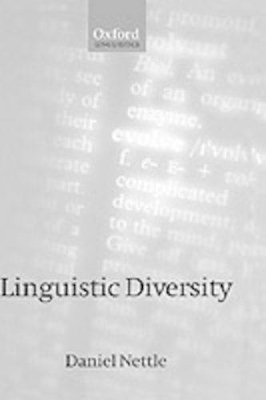
Linguistic Diversity
Oxford University Press (Verlag)
978-0-19-823858-4 (ISBN)
There are some 6,500 different languages in the world, belonging to around 250 distinct families and conforming to numerous grammatical types. This book explains why. Given that the biological mechanisms underlying language are the same in all normal human beings, would we not be a more successful species if we spoke one language? Daniel Nettle considers how this extraordinary and rich diversity arose, how it relates to the nature of language, cognition, and culture, and how it is linked with the main patterns of human geography and history.
Human languages and language families are not distributed evenly: there are relatively few in Eurasia compared to the profusion found in Australasia, the Pacific, and the Americas. There is also a marked correlation between biodiversity and linguistic diversity. The author explains the processes by which this distribution evolved and changes still. To do so he returns to the earliest origins of language, reconstructing the processes of linguistic variation and diffusion that occurred when humans first filled the continents and, thousands of years later, turned to agriculture. He ends by examining the causes of linguistic mortality, and why the number of the world's languages may halve before 2100.
Linguistic Diversity draws on work in anthropology, linguistics, geography, archaeology, and evolutionary science to provide a comprehensive account of the patterns of linguistic diversity. It is written in a clear, lively and accessible style, and will appeal broadly across the natural and human sciences, as well as to the informed general reader.
1. Introduction ; 1.1 Preamble ; 1.2 The Family Tree Model ; 1.3 The Linguistic Item and Linguistic Pool ; 1.4 Levels and Diversity in the Linguistic Pool ; 1.5 Justification, Disguised as Apology ; 1.6 The Need for an Interdisciplinary Approach ; 2. Language Evolution: Basic Mechanisms ; 2.1 Introduction ; 2.2 The Neutral Model ; 2.3 Problems with the Neutral Model ; 2.4 Additional Amplifiers ; 2.5 Summary and Conclusions ; 3. Language Evolution: Computer Simulations ; 3.1 Introduction ; 3.2 The Use of Computer Simulations ; 3.3 Methods ; 3.4 Basic Results ; 3.5 More Realistic Social Structures ; 3.6 Social Selection ; 3.7 Functional Selection ; 3.8 Discrete Traits ; 3.9 Discussion ; 3.10 Adaptive Significance of Social Selection ; 4. Language Diversity: Patterns in Space ; 4.1 Introduction ; 4.2 Quantifying Language Diversity ; 4.3 Vectors of Language Spread ; 4.4 Case Studies ; 4.5 Ecological Risk as a Universal Constraint ; 4.6 Testing the Theory: Methods ; 4.7 Testing the Theory: Results ; 4.8 Hunter-gatherers ; 4.9 Conclusions ; 5. Language Diversity: Changes in Time ; 5.1 Introduction ; 5.2 The Palaeolithic Equilibrium ; 5.3 The Neolithic Punctuation ; 5.4 The Neolithic Aftershock ; 5.5 The Industrial Punctuation ; 5.6 Prospect ; 6. Phylogenetic Diversity ; 6.1 Introduction ; 6.2 Lineages and Stocks ; 6.3 The Distribution of Stocks ; 6.4 Stocks and Time: Nichol's Model ; 6.5 Stocks and Time: An Alternative Model ; 6.6 Validating the Model ; 6.7 Conclusions ; 7. Structural Diversity ; 7.1 Introduction ; 7.2 Causes of Structural Diversity ; 7.3 Geographical Distribution of Structural Diversity ; 7.4 Case Study: Phonological Inventory and the Lexicon ; 7.5 Conclusions ; Epilogue ; Appendix - Global Language Diversity Data
| Erscheint lt. Verlag | 6.5.1999 |
|---|---|
| Zusatzinfo | numerous graphs |
| Verlagsort | Oxford |
| Sprache | englisch |
| Maße | 161 x 242 mm |
| Gewicht | 412 g |
| Themenwelt | Geisteswissenschaften ► Sprach- / Literaturwissenschaft ► Sprachwissenschaft |
| Naturwissenschaften ► Biologie ► Evolution | |
| Naturwissenschaften ► Biologie ► Humanbiologie | |
| Naturwissenschaften ► Geowissenschaften ► Geografie / Kartografie | |
| Sozialwissenschaften ► Ethnologie | |
| Sozialwissenschaften ► Soziologie | |
| ISBN-10 | 0-19-823858-4 / 0198238584 |
| ISBN-13 | 978-0-19-823858-4 / 9780198238584 |
| Zustand | Neuware |
| Haben Sie eine Frage zum Produkt? |
aus dem Bereich


